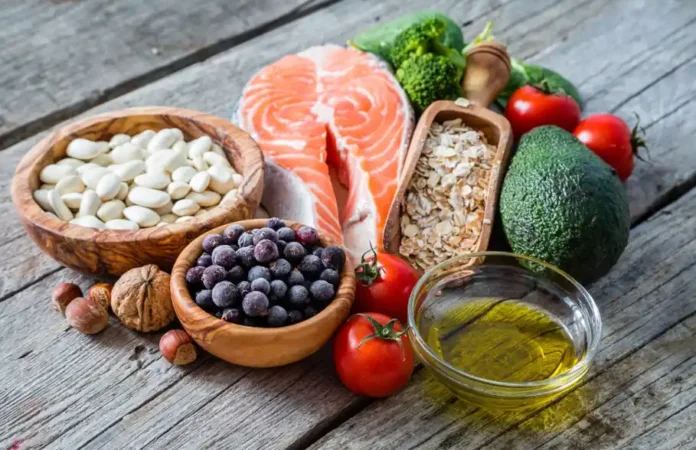The Nordic Diet is a healthy eating pattern based on traditional foods from Scandinavia. It emphasizes whole grains, root vegetables, berries, and fatty fish, promoting heart health, weight loss, and sustainability. Its focus on seasonal and local produce supports both the environment and long-term wellness.
KumDi.com
The Nordic Diet is a heart-healthy and sustainable eating plan inspired by the traditional cuisine of Northern Europe, especially Denmark, Sweden, Norway, Finland, and Iceland. Featuring whole grains, berries, root vegetables, and omega-3-rich fish, the Nordic Diet promotes long-term wellness, environmental sustainability, and weight control—making it one of the most practical and nutritious diets in the world.
Table of Contents
What is the Nordic Diet?
The Nordic Diet is a heart-healthy and environmentally sustainable way of eating inspired by the traditional cuisines of Denmark, Sweden, Norway, Finland, and Iceland. Designed by nutritionists and chefs, it focuses on local, seasonal, and whole foods to promote both personal health and ecological well-being. Unlike restrictive or fad diets, it encourages balanced meals using readily available natural ingredients.
Key Principles of the Nordic Diet
- Emphasis on local and seasonal produce
- High consumption of whole grains such as rye, oats, and barley
- Frequent intake of fatty fish like salmon, herring, and mackerel
- Use of rapeseed (canola) oil instead of butter or margarine
- Reduction of red meat and processed foods
- Inclusion of legumes, nuts, and berries
- Focus on sustainable and mindful eating habits
Foods to Eat and Avoid
Foods to Eat
- Whole grains: rye bread, oats, barley
- Vegetables: root vegetables, cabbages, leafy greens
- Berries: lingonberries, blueberries, cloudberries
- Fatty fish: salmon, trout, herring, mackerel
- Lean meats: wild game, chicken, turkey
- Legumes and nuts: lentils, beans, almonds
- Dairy: skyr (Icelandic yogurt), low-fat milk
- Healthy fats: rapeseed oil, small amounts of butter
Foods to Limit or Avoid
- Processed and red meats
- Refined grains and white bread
- Sugary drinks and desserts
- High-sodium foods
- Deep-fried and fast food
- Excessive alcohol
Health Benefits of the Nordic Diet
The Nordic Diet is supported by scientific studies for its positive effects on heart health, metabolic function, and overall well-being.
- Supports weight loss through high fiber and low sugar
- Lowers blood pressure and LDL cholesterol
- Reduces inflammation due to omega-3-rich fish and antioxidants
- Improves gut health with fermented dairy and fiber
- Provides sustainable energy from complex carbs

Nordic Diet vs Mediterranean Diet
While both are plant-forward, anti-inflammatory diets with proven health benefits, they differ in key ingredients and origins.
Nordic Diet
- Origin: Northern Europe
- Oil: Rapeseed (canola) oil
- Grains: Rye, barley, oats
- Fruits: Berries
- Fish: Cold-water fish like herring
Mediterranean Diet
- Origin: Southern Europe
- Oil: Olive oil
- Grains: Wheat, rice
- Fruits: Citrus, grapes
- Fish: Warm-water fish like sardines
Sample 7-Day Nordic Diet Meal Plan
Day 1
Breakfast: Skyr with oats and fresh berries
Lunch: Rye bread with smoked salmon and avocado
Dinner: Grilled mackerel with roasted root vegetables
Day 2
Breakfast: Barley porridge with lingonberries
Lunch: Lentil soup with rye crackers
Dinner: Oven-baked cod with cabbage and dill salad
Day 3
Breakfast: Oatmeal with nuts and apples
Lunch: Quinoa salad with kale and chickpeas
Dinner: Wild game stew with carrots and turnips
Day 4
Breakfast: Skyr with granola and blueberries
Lunch: Smørrebrød (open-faced rye sandwich) with herring
Dinner: Baked trout with mashed parsnips and greens
Day 5
Breakfast: Whole grain toast with almond butter and banana
Lunch: Barley salad with beans and beets
Dinner: Grilled salmon with steamed broccoli and rye pilaf
Day 6
Breakfast: Rye pancakes with berry compote
Lunch: Vegetable stew with potatoes and cabbage
Dinner: Chicken breast with roasted carrots and barley
Day 7
Breakfast: Skyr smoothie with oats and berries
Lunch: Rye crackers with cheese and cucumber
Dinner: Mushroom and lentil casserole with herbs
Sustainability and Environmental Impact
The Nordic Diet is not only good for your body but also for the planet. It encourages eating in harmony with nature through:
- Emphasis on local and seasonal produce
- Reduced red meat consumption
- Minimal food waste
- Preference for organic and wild-caught foods
- Environmentally responsible farming and fishing practices
Scientific Research on the Nordic Diet
Multiple studies have shown the Nordic Diet to improve health outcomes:
- The NORDIET study showed reductions in cholesterol and waist size
- The SYSDIET study found lowered inflammation and blood pressure
- A 2018 meta-analysis reported reduced risk of cardiovascular disease
- Long-term adherence improves insulin sensitivity and metabolic markers
Who Should Try the Nordic Diet?
The Nordic Diet is ideal for:
- People seeking a heart-healthy, sustainable lifestyle
- Those looking to lose weight without calorie counting
- Individuals who enjoy natural, whole foods
- Anyone wanting to reduce their environmental footprint
- Those in colder climates or with access to Nordic-style ingredients

FAQs
What is the Nordic Diet and why is it healthy?
The Nordic Diet is a health-focused Scandinavian eating plan based on local foods like root vegetables, rye, and fish. It’s known for reducing inflammation, improving heart health, and aiding in sustainable weight loss thanks to its natural, nutrient-dense ingredients.
How does the Nordic Diet compare to the Mediterranean Diet?
While both promote healthy eating, the Nordic Diet uses rapeseed oil and features local grains like rye and oats, whereas the Mediterranean Diet uses olive oil and wheat. Both are heart-healthy and include fish, fruits, and vegetables.
Can I follow a Nordic meal plan outside of Scandinavia?
Yes, you can adapt the Nordic Diet globally by choosing local substitutes for fish, berries, and grains. The focus is on whole, seasonal, and unprocessed foods, making it a flexible and accessible sustainable eating approach.
Is the Nordic Diet good for weight loss?
Absolutely. The Nordic Diet supports healthy weight loss due to its high fiber, low sugar, and omega-3-rich foods. Meals are filling and balanced, reducing the need for calorie counting while improving metabolic health.
What are the best foods to eat on the Nordic Diet?
Key Nordic Diet foods include fatty fish like salmon, whole grains like rye and oats, berries, root vegetables, legumes, and skyr. These ingredients support heart health, reduce inflammation, and promote sustainability.





